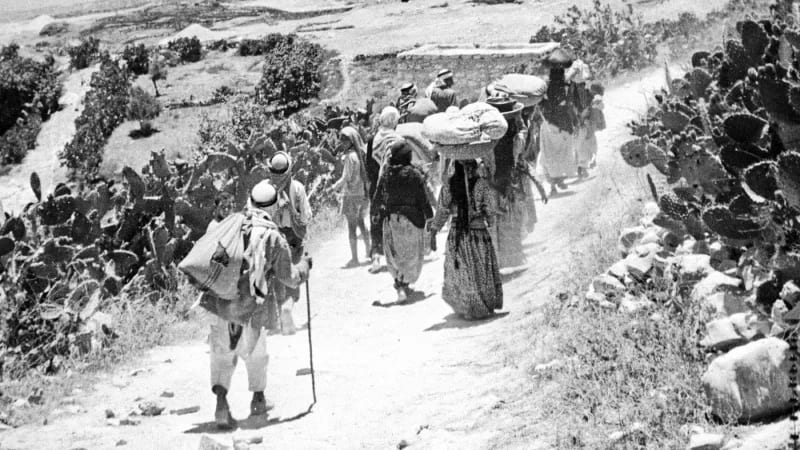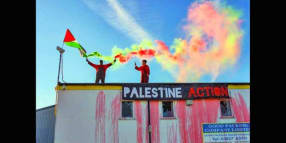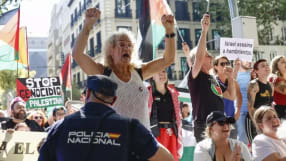No olvides. Nakba. Do not forget. No olvides. 15 May/o. ESP ENG

La "Catástrofe", expulsión por la fuerza terrorista sionista. 750,000 Palestinian expelled from their homeland by Zionist militia in 1948
ESPAÑOL
El 15 de mayo marca el aniversario de la Nakba, un suceso histórico que marcó el antes y el después del devenir del pueblo palestino. Conocer la Nakba es de vital importancia para entender la evolución de una situación trágica que se ha cobrado miles de vidas a lo largo de los más de 100 años de ocupación de Palestina.
Durante el mandato británico sobre la Palestina histórica y al amparo de la Declaración de Balfour de 1917 que preveía la creación de un ‘’hogar nacional judío’’ en la misma, se inició un proceso de emigración judía procedente principalmente de Europa central y oriental, donde el antijudaísmo se intensificaba. Progresivamente, se establecieron colonias judías y ante la resistencia de la población palestina local y sus demandas de independencia, surgieron grupos paramilitares judíos que recibían el apoyo de muchos de los Estados occidentales en los que, paradójicamente, las comunidades judías eran perseguidas.
En esta situación y con el fin de la II Guerra Mundial, en 1947 la ONU aprobó un plan de partición que dividiría Palestina en dos para establecer dentro de ella un Estado árabe y otro judío, mientras que Jerusalén quedaría bajo un régimen internacional. En ese momento, la violencia de los grupos paramilitares judíos se intensificó, multiplicándose las masacres de personas palestinas, la destrucción de aldeas y la expulsión de sus hogares.
La violencia culmina con la llamada declaración de independencia de los colonizadores judíos el 14 de mayo de 1948, estableciéndose el Estado de Israel. Se inicia así la Nakba o catástrofe palestina, que lleva a la derrota militar de esta y sus aliados árabes; con la ocupación del 77 % del territorio de la Palestina histórica, incluida la mayor parte de Jerusalén; y con la expulsión de más de la mitad de la población palestina de su territorio. El resto del territorio, que bajo el plan de partición correspondería al Estado palestino, quedó bajo el control de Jordania y Egipto. Expulsión y desplazamiento forzoso de la población palestina
La Nakba provocó un exilio forzoso que llevó a más de 700 000 personas lejos de sus hogares. Ellas y sus descendientes han sido forzadas a vivir como refugiadas, apartadas de sus casas y, en muchos casos, también de sus seres queridos. Así, el pueblo palestino sufre un largo proceso de desposesión, expulsión y falta de acceso a derechos dentro y fuera de su territorio. Numerosas resoluciones de la ONU han condenado reiteradamente el proceso ilegal de ocupación que Israel ha ido afianzado con el paso de los años y las décadas.
Hasta el día de hoy, muchas de las familias afectadas aún guardan las llaves de los hogares que se vieron forzadas a dejar, con la esperanza de volver a usarlas de nuevo algún día. Estas llaves se han convertido en uno de los principales símbolos de la resistencia del pueblo palestino y de su memoria colectiva que, conservándolas, manifiesta su deseo y su derecho al retorno, contemplado asimismo por la ONU.
ENGLISH
Palestine was part of the Ottoman Empire for hundreds of years until it was captured by Great Britain at the end of World War One (1914-18).
The League of Nations gave Britain a "mandate" over Palestine after the war, in an arrangement that did not take into account the wishes of the native Palestinian population.
The declared aim of the League of Nations mandates was "the rendering of administrative assistance and advice" to the native populations until they are deemed capable of standing alone as independent states.
However, in the case of Palestine, the British Mandate incorporated the "Balfour Declaration" that pledged to establish "in Palestine a national home for the Jewish people", who made up less than 10 percent of the population at the time.
During the mandate years between 1923-48, Britain facilitated the immigration of European Jews to Palestine, increasing their population ten-fold, from 60,000 in the pre-Mandate era to 700,000 by 1948.
They also trained Zionist armed groups, provided them with weapons and allowed them a degree of self-governance.
Meanwhile, the native Palestinian population was violently suppressed following rebellions that called for independence and rejected European Jewish immigration.
In February 1947, Britain announced it would terminate the mandate and turn the question of Palestine over to the United Nations.
The UN adopted a partition plan in November 1947, which divided Palestine into two parts: 55 percent to a Jewish state, and 45 to an Arab state, while keeping Jerusalem under international control.
Palestinians were not consulted over the proposal which never materialised. From that point on, Zionist groups began their attacks.
The Nakba
Drawing upon military plans devised as early as 1945, Zionist armed groups began to systematically increase attacks against Palestinians from December 1947 with the aim of forcing them out.
Zionist strategy culminated in Plan Dalet, the blueprint for their military action that called for "destruction of villages" by "setting fire to, blowing up, and planting mines in the debris".
It also said that "in the event of resistance, the armed force must be destroyed and the population must be expelled outside the borders of the state".
Zionist forces used various tactics to force Palestinians out, including bombing campaigns, massacres and psychological warfare, among other means.
Unarmed civilians were indiscriminately killed during the campaign, some of whom were buried in mass graves.
Between December 1947 and 14 May 1948, some 175,000 Palestinians were expelled and 200 villages and urban centres destroyed and occupied.
On 14 May 1948, the State of Israel was unilaterally declared, a day before the British Mandate officially expired.
Arab armies then entered Palestine to push back against the Israeli military advances.
Hostilities were officially brought to an end by July 1949 with the signing of armistice agreements between Israel and the Arab states.
Israel captured 78 percent of historic Palestine, while the remaining 22 percent was under Arab control.
Aftermath
By the end of the war, Zionist forces had killed 13,000 Palestinians, destroyed and depopulated around 530 villages and towns, committed at least 30 massacres and expelled 750,000 people.
Around 150,000 remained within the boundaries of the newly formed state of Israel, many of them internally displaced.
Israel then passed laws by which it seized Palestinian property and assets left behind by those expelled, including land, homes, cash, stocks, furniture, companies and other movable assets.
They also enacted the Law of Return, which grants Israeli citizenship to Jews who relocate to Israel, while denying Palestinian refugees from returning to their homeland.
Today, there are 5.8 million registered Palestine refugees living in dozens of camps in the occupied West Bank, the Gaza Strip, Jordan, Syria and Lebanon.
Internally displaced Palestinians, who were granted Israeli citizenship, amount to around two million people.
Every year, on 15 May, Palestinians across the world mark the Nakba, which they say has continued since 1948 in different forms of war, occupation, siege, home demolitions, land confiscations and more.


The only "democracy" in Western Asia, againts press freedom. La única "democracia" en Asia Occidental, en contra de la libertad de prensa. ENG ESP
Closure of Army Radio after 75 years. Cierre de la Radio del Ejército, tras 75 años
Publicado hace 4 días.
Palestine Action. Huelga de hambre. Hunger strike ESP ENG
La huelga de hambre no puede quedar aislada. The hunger strike cannot be isolated.
Publicado hace 5 días.
Palestine. Celebrating Hanukkah atop the ruins. Janucá sobre ruinas. ENG ESP
The Israeli state has weaponized and defiled Jewish traditions. El Estado de Israel ha utilizado y profanado las tradiciones judías
Publicado hace 9 días.
Gaza como cementerio. Gaza as graveyard ESP ENG
Gaza, cementerio de la Humanidad. Gaza, graveyard of the Humanity
Publicado hace 10 días.
España-Israel, una colisión tan indeseada como inevitable (Real Instituto Elcano)
Las tibias medidas contra Israel desatan la furia contra España
Publicado hace 13 días.
Boycott Teva for beginners. Boicot Teva para principiantes. ENG ESP
How to Boycott Teva Medicines: A Guide to “Direct Action”. Como hacer boicot a Teva: una guía de "acción directa"
Publicado el 10 de diciembre.
Zionism is corrupting Israel (Elbit, weapons and more). El sionismo corrompe Israel (Elbit, armas, y más) ENGL ESP
Zionism is corrupting Israel: its prime minister and its companies (Elbit weapons, Teva pharmaceuticals, for example), etc. El sionismo pudre Israel: su primer ministro y sus empresas (Elbit de armamento, Teva de medicamentos, por ejemplo), etc
Publicado el 10 de diciembre.
Israel’s Latest Military Tech. Sell. La última tecnología militar de Israel. Venta
Tested in Gaza, Wanted by the West. Probada en Gaza, buscada por Occidente
Publicado el 6 de diciembre.Ver más / See more






